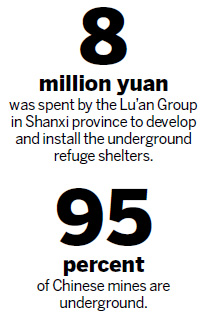Society
Test results in success for coal mine shelter
Updated: 2011-04-12 08:09
By Lan Tian and Sun Ruisheng (China Daily)
Taiyuan - A team of 80 coal miners and support staff members finished a 48-hour stay inside an underground refuge chamber in a coal mine in North China's Shanxi province on Sunday, marking success for the country's first manned test of a refuge chamber for underground coal mines.
|
![A team of 80 coal miners and support staff members stay inside an underground refuge chamber in a coal mine in North China's Shanxi province to test its safety on Sunday. [Zhang Yun / China News Service] Test results in success for coal mine shelter](../../attachement/jpg/site1/20110412/002170196e1c0f0dd9040a.jpg) A team of 80 coal miners and support staff members stay inside an underground refuge chamber in a coal mine in North China's Shanxi province to test its safety on Sunday. [Zhang Yun / China News Service] |
"The chamber is a bit crowded, but my co-workers and I didn't feel much discomfort during our two-day stay," Shen Haisheng, a 29-year-old miner who participated in the test, told China Daily.
"The use of refuge shelters is really reassuring to me and my families, since it makes us miners better able to survive a mine accident," he said.
|
||||
"The test turned out to be very successful, which provided us with many useful data for further improvement," said Jin, who, under a national program of technical research, has played a lead role since 2006 in developing the chamber and related refuge structures.
The test chamber is equipped with devices that provide oxygen, electricity and telecommunications and has a permanent borehole that allows air, fresh water and food to be lowered down from above ground. The shelter, which measures 39 meters by 3.5 meters by 3.05 meters, is large enough to keep up to 100 miners alive for 96 hours after a coal mine disaster, he said.

Built in May 2010, the refuge system was introduced as a test project at the Changcun Coalmine, which is the first mine in China to have such a structure.
Besides the chamber, the mine is also equipped with 16 underground escape capsules. Each capsule can be moved by a track to the chamber and bears a supply of oxygen, an air purifier and an air conditioner.
It can keep up to 12 miners alive for 96 hours, said Zheng Xiangju, deputy director of the mine's chief engineer office.
To develop and install the underground refuge shelters, the Lu'an Group spent about 8 million yuan ($1.22 million) during its five years of cooperation on the project with the University of Science and Technology Beijing, he said.
"We went through lots of problems because (China) offered no precedent to follow," he said. "The country did not have a national standard for building such shelters. But the most difficult phase has passed."
Emergency shelters for coal mines have attracted much public attention since October 2010, when 33 Chilean miners were pulled to safety after being trapped underground for 69 days. An underground emergency shelter was believed to have been essential in saving their lives.
By 2015, all mines in China are to undergo safety improvements meant to make it easier to monitor for dangerous conditions and respond to emergencies, Zhao Tiechui, head of the State Administration of Coal Mine Safety, said in May 2010.
Safety chambers will help ensure workers caught in a disaster have shelter, oxygen and clean water, he said.
At the encouragement of the country's coal mine safety watchdog, tests of emergency shelters began to be conducted in five State-owned coal mines in the coal-rich Shanxi province in 2010.
In January, the central government released a national standard to govern the construction and management of the shelters and issued a mandatory provision requiring all mines to contain underground escape capsules and other safety improvements by 2013.
Chinese mines are prone to being damaged by gas blasts, flooding and other disasters, largely because 95 percent of them are underground, Xinhua reported.
The emergency shelters are to serve as the last safeguard for miners in all kinds of mine disasters and have been widely used in the United States, Canada, South Africa and other countries, according to professor Jin.
"The widespread use of the refuges will greatly improve the safety of China's coal mines," he said.
Specials

Share your China stories!
Foreign readers are invited to share your China stories.

Art auctions
China accounted for 33% of global fine art sales.

Waiting for drivers' seat
Lack of sponsorship appears to be why Chinese drivers have yet to race in a Formula 1 event



